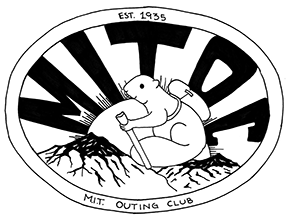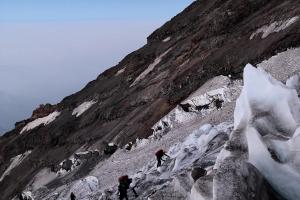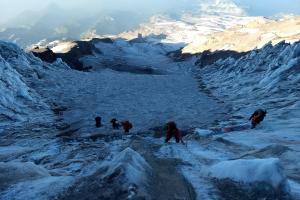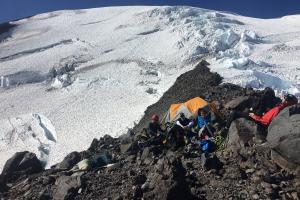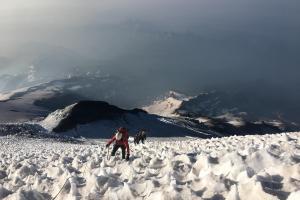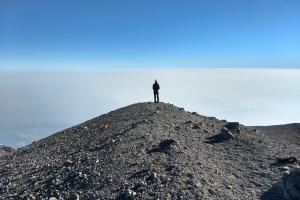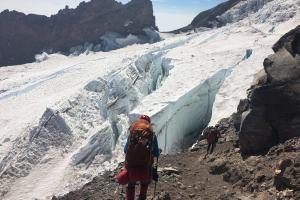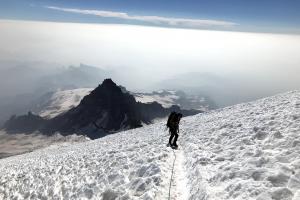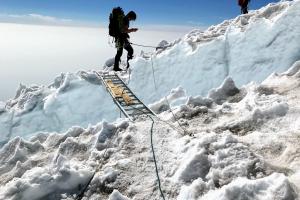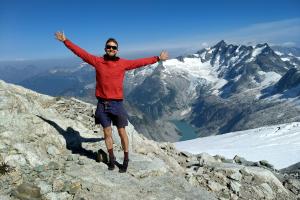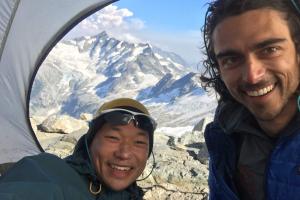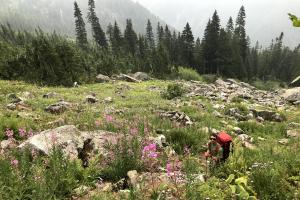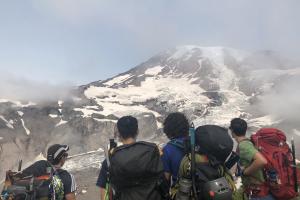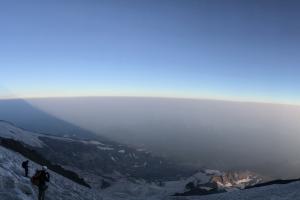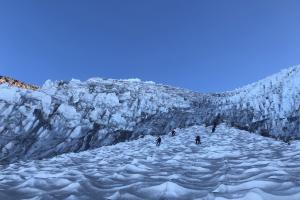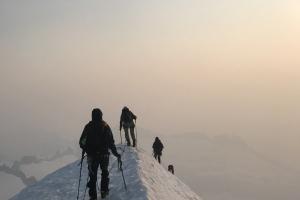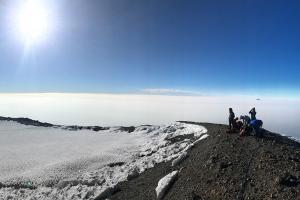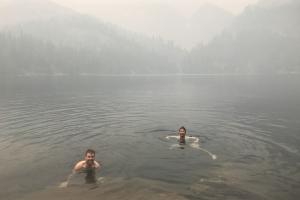Adventurer/s:
Dates of Trip:
We hope this report captures a glimpse of the beauty we encountered, encourages respect for nature and environment, and perhaps inspires you to discover for yourself the magic this planet has to offer.
Philosophically, mountaineering mainly serves as a vehicle to discover where the boundary between the possible and impossible is, given the constraints of your body, the weather conditions, and the mountain. Sometimes, you end up moving the seemingly impossible into the realm of the possible, and that is just the most empowering feeling.
We also encourage you, as in the spirit of MITOC, to spend time to develop the requisite skills and fitness, and plan appropriately for your adventure out. While you might aspire to be a badass like Walter Bonatti or Marc Leclerc, it’s important not to confuse badass with stupid and end up in a precarious situation for lack of planning or learning the requisite technical skills.
Itinerary:
- Mount Rainier via the Kautz route (3 days/2 nights)
- Eldorado Peak (2 days/1 night)
- Trappers Peak and Thornton Lakes (half-day hike)
Mount Rainier via Kautz
We spent the first day finishing our planning with the input of the Rangers, and this was key:
First, we chose to do a carryover, ascending via the Kautz route in one day, and descending via the normal DC route the next day. Chatting with Rangers about route choice, conditions, weather, and recent successful summits, we floated the idea of leaving our tents, sleeping bags, and mats at the first night’s camp site (Camp Hazard), going for a light, fast summit via the ice climbing pitches and descending via the same route to collect our tents, which we saw a fast two-person team do next to us during our ascent of the mountain. We opted for a more conservative approach that involved carrying all our gear with us, even up the ice pitches, as we figured we could set up a hauling system if the ice climbing became too gnarly.
Second, we instructed the rangers (who require everybody to check in and out of their climbs) to only activate the search and rescue in the event our party didn’t check in after three nights. Since one member of our party carried a Personal Locating Beacon (PLB), and the weather had been consistently warm (just below freezing at the summit), we allowed ourselves an extra night in case we were delayed for any reason (which we were, as explained later). Of course, we also carried food and fuel for three days.
Finally, since only half of us had previously climbed together during a trip to Iceland, and since we wanted to make sure that our entire team knew how to set up the same crevasse rescue hauling system, we literally broke the ice on the Nisqually glacier during our first day at Mt. Rainier. After a few trials, we felt we were ready.
We started the climb the following day. Since the usual approach via the Nisqually glacier was broken up with crevasses in these late season conditions, we unfortunately had to start 3,000 feet lower at the Comet Falls trailhead (at ~3000 feet sea level) in order to follow the Van Trump approach towards Lower Camp Hazard at about 11,000 feet. We saw far fewer alpine flowers than advertised, and none of the sampled ones tasted good – still nice, so just a typical expectation management issue.
We arrived after 11 hours at Lower Camp Hazard, and located a spot for our camp that was safe from rockfall. This first night was clear with little wind, so I cuddled into my sleeping bag outside and fell asleep to a gazillion stars.
We decided to wake at 2am, later than the recommended midnight departure, hoping the extra time would allow the ice melt from the previous day to refreeze (freezing level was around 12,000 feet, a little bit higher than camp), and hiked up to the notorious rock step. Avi and David Cain had climbed this route about a month earlier and warned us that they almost got taken out by a van-sized piece of ice from seracs on the traverse between the rock step and the first ice pitch. I tried to make out where we could traverse safely, but noticed that we were also scrambling on extremely loose rock - more often than not, holds would break loose, leaving me with just a rock in my hand to thank sarcastically before tossing away. We decided to traverse unroped (that way, if one person were to be hit by debris, it wouldn’t take out the entire rope team), leaving enough space between each other to dodge icefall, as we had been advised to do by Avi and Dcain, and we managed to reach the base of the first ice pitch safely.
The ice pitches were easier than expected (WI2-3): the vast majority was nicely stepped out over weird penitentes, so that several of us used only a single ice tool, and felt safe simul-climbing with about 10 ice screws between the party for protection. Marc Chauvin and Rob Coppolillo mention that the risks of simul-climbing are often underestimated and therefore overused by many teams, and so the technique should be reserved for sections where everyone on the party feels comfortable soloing. In the end, we did pitch out one 15-foot section led by Harvard Mountaineering Club President Vlad, who has gnarly ice climbing experience at 20k feet (you should ask him about the details).
We had been warned, both by the rangers as well as Avi and Dcain, about the terrain above the ice pitches, which requires exhaustive end-running through a crevasse maze and arduous anchor building for belaying across thin snowbridges. We didn’t quite expect that it would take us almost 12 hours to get from Lower Camp Hazard at 11,000 feet to the next possible bivy site on the Wapowety cleaver at 13,000 feet – something we thought would take about 3 hours. Navigating around crevasses is tricky since it is very difficult to plan out a route before encountering them, especially in late season conditions when snowbridges rapidly disappear. Our strategy was to remain roped at all times, and ensure that the leader was able to see as much as possible of the terrain: this involved moving the entire rope team to higher points to search for safe crossings over a crevasse, and actively communicating within the rope team about everyone’s vantage point.
Anyway, nobody complained about not summitting that day as we safely slurped Trader Joe’s Miso Ramen on the Wapo. All of us are used to some kind of endurance sport, so this was a humbling experience for each of us. Most notably, Carlo, being one of the fittest people on the team, did all of this in a vegan way (no salami, brisket, down, leather, etc.). When I saw this, I realized that I really don’t need to eat meat in my cozy life back in Cambridge, or on the mountain either.
Coming from sea-level, all but Carlo woke up with a headache the next morning (Ibuprofen and Gatorade for the win). Then the same thing again: navigate around some crevasses while avoiding or passing quickly through potential ice fall regions below seracs, and in this way we were able to efficiently locate safe crevasse crossings and make speedy progress. We finally summited, and after spending 30 minutes or so looking at the weeny bit of steam rising from the crater, taking photos, and eating sandwiches, we started our descent via the normal route a.k.a. the Disappointment Cleaver (DC) route.
I was really looking forward to an easy descent via the standard DC route, which sees the vast majority of Rainier summit traffic and which features a stepped-out boot pack to follow as well as Ranger-maintained ladders over crevasses. Still, the trail featured plenty of objective hazards: rockfall, icefall, steep wet rock funneling straight into a crevasse, and some questionably supported ice-blocks referred to as ‘the popcorn’ by park rangers. In retrospect, the Kautz route definitely felt safer to us, if a team knows how to manage the slightly more technical requirements (e.g., ice climbing and glacier navigation).
Speaking of uncontrollable: we were dismayed with the lack of courtesy, foresight, and safety by seven guided, three-person rope teams on their way up the mountain. At one point, they caused our rope team to be stalled directly below a rockfall area where we had just witnessed rocks tumbling onto 60 seconds prior. While we felt that the rockfall hazard and our approach should have been clearly visible to them, it took a fair bit of negotiating while stalled in that area to get the rest of the teams to stop and let us pass.
We only started feeling safe again once we reached Camp Muir, where our moods lightened and any lingering headaches disappeared with the lower elevation. After that, we just had to descend an easy snowfield, time to practice boot-skiing and glissading!
All in all, if we were to climb the Kautz Route again, we would do it earlier in the season to avoid the endless end-running around crevasses, and we would plan to get more than 80 percent of calories from snack food for those unexpected longer days when it’s not possible to set up the stove, and we would probably descend the Kautz by rapping off of 0-threads. Finally, we would put even more sunscreen on the bottoms of our noses.
Eldorado peak
After a rest day, we drove to the North cascades, and climbed Eldorado peak: this was Type I fun! We saw a bear and her two cubs, a mountain goat, and we camped at what Carlo described in his Italian accent as ‘possibly the best view… ever seen.’ On the second day, we summitted, but the smoke from nearby wildfires had rolled in, creating a surreal white where-are-we experience that Charlie referred to as ‘inside the pingpong ball.’ The snow was firmly packed but the ridge was steep, and so we decided to rope up and place pickets. The final descent back to the car was grueling, and involved descending in steep forest and across a seemingly endless talus field that wrecked our knees.
Trappers peak and Thornton lake
The next day we hiked up Trappers peak (5/10, plus a point for each pound of trail blueberries consumed per person), and swam in a remote alpine lake – Thornton lake (8/10) – it looked like something right out of an airplane holiday destination magazine. Sadly, Carlo’s knee was busted and he needed to heal for a marathon he had been training for to qualify for the Boston Marathon, so he ended up sleeping outside of a diner for the day.
Camping:
Besides the backpacking permit, we didn’t pay for a single campsite. Instead we took advantage of free dispersed camping and found some real gems. We learned that increased time investment driving down fire roads in National forest equates to better camping spots.
Thanks
Shout out to Paul for keeping us hydrated with relentless ice melting, Vlad for keeping our electrolyte balance in check with his summit candy, Nick for loading/unloading 5 dudes + kit into a seemingly tiny SUV far too many times, Carlo for his inspiring vegan idealism, and Charlie for making us believe we actually heard a mountain lion (or puma or cougar or …).
Thanks to the Sean Collier award as well as the beta from the MITOC community (Avi Cramer and David Cain) for making this possible and allowing us to learn, experience, and grow as a team. We have no doubt that this will serve as invaluable experience for future summit bids.
